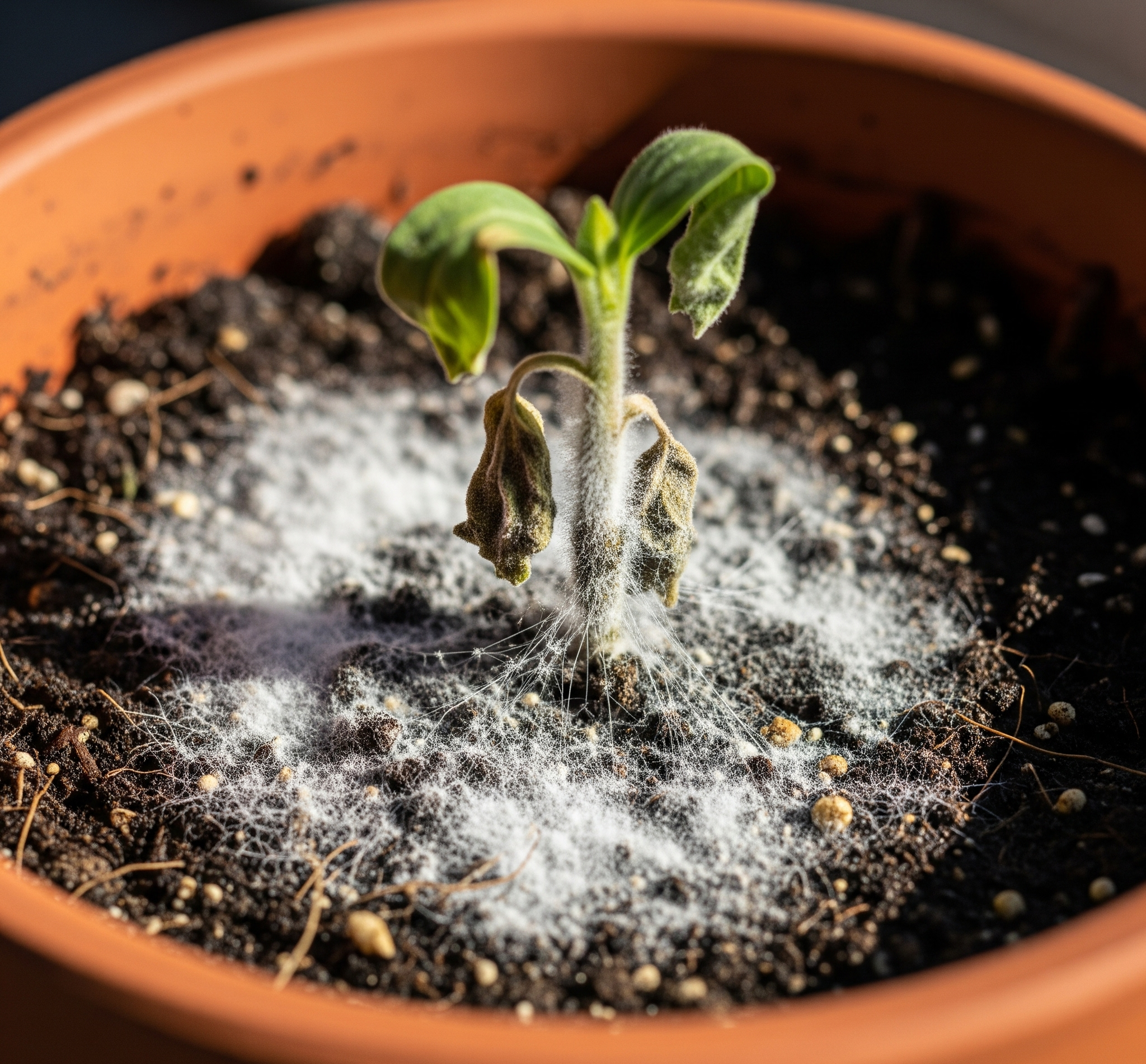Understanding the White Mold: What Is It?
White mold creeping over your seedlings may look harmless, even a little fluffy and innocent. But don’t be fooled. That powdery invader is usually a sign of trouble brewing in your grow trays. Most commonly, it’s saprophytic fungi such as Botrytis, Rhizopus, or Sclerotinia, all of which thrive in moist, humid environments and feast on decaying organic matter.
So why are your baby plants falling victim to this unwanted guest? Seedlings are delicate and often grow in environments that are, unfortunately, mold’s dream home: warm, wet, and poorly ventilated. Add a bit of organic matter from your potting mix or tray, and you’ve just set out the welcome mat for spores.
Still, not all white fuzz is bad news. Root hairs, for example, can resemble mold but are signs of healthy root development. A quick test? Mold wipes off easily with a cotton swab; root hairs stay attached. Some beneficial fungi also form symbiotic relationships with plants, like mycorrhizae, and don’t need to be removed. It’s all about reading the signs right.
Why White Mold on Seedlings Is a Big Deal
You might think, “It’s just a little mold, what’s the worst that can happen?” Sadly, plenty. Mold weakens seedlings by competing for nutrients and oxygen in the soil. It can also lead to damping-off disease, a lethal condition where the seedling’s stem rots at the base, causing it to collapse like a felled tree.
It’s not just about one sick plant either. Mold spreads through spores that travel in the air or cling to tools and hands. Today’s white fuzz could become tomorrow’s tray of wilted, lifeless greens. In shared grow spaces or greenhouses, one outbreak can affect dozens of seedlings for days.
Top Causes of White Mold in Seedling Trays
Overwatering: The Number One Culprit
Most mold issues start with too much water. Seedlings need consistent moisture, not soggy soil. When soil stays waterlogged, it becomes anaerobic, encouraging fungal growth and suffocating roots. Less is more when it comes to watering.
Poor Airflow and Stagnant Conditions
A lack of airflow creates a humid microclimate, which is ideal for mold spores to germinate and grow. Stale air leads to condensation buildup on leaves and soil, trapping moisture where it shouldn’t be.
The Hidden Dangers of Old or Dirty Seed-Starting Materials
Reusing trays, pots, or even leftover potting mix without proper sterilisation is a common mistake. Old materials can harbour dormant spores that spring to life once conditions are right.
Humidity Overload: When Your Grow Space Gets Too Cosy
High humidity accelerates mold growth exponentially. While seedlings love a bit of warmth and moisture, excessive humidity creates the equivalent of a fungal spa.
Quick Fixes: How to Treat White Mold Without Harming Your Seedlings
Natural Remedies That Work (Like Cinnamon and Neem Oil)
Cinnamon isn’t just for your coffee, it’s a powerful antifungal. Sprinkle it lightly over the moldy soil. Neem oil, a plant-based extract, also helps disrupt mold growth without harming your seedlings. A diluted hydrogen peroxide solution (1 part peroxide to 4 parts water) can also help, but use sparingly.
Adjusting Your Watering Schedule the Right Way
Let the top layer of soil dry out between waterings. Seedlings don’t need daily watering; check with your finger. If the top inch is dry, it’s time. Otherwise, hold off.
Creating Better Airflow Without Fancy Equipment
Even a small desk fan on low can make a difference. Open a window or move trays to a space with better circulation. Air movement prevents moisture from settling.
When to Gently Scrape Off White Mold and When to Start Over
If the mold is surface-level and your seedlings still look healthy, gently remove the top layer of soil and replace it with a fresh, sterile mix. If your seedlings are wilting or discoloured, it’s often better to start over than risk infecting others.
Preventing White Mold Before It Starts
Setting Up a Seed-Starting Station That Discourages Mold
Use trays with drainage holes. Elevate them slightly to allow airflow underneath. Avoid clustering trays too tightly. Space gives seedlings room to breathe.
Sterilising Trays, Pots, and Tools Like a Pro
Soak tools and containers in a 10% bleach solution or use boiling water to sanitise. Do this before every new planting cycle to destroy lingering spores.
Picking the Right Growing Medium for Healthy, Mold-Free Seedlings
Choose a well-draining, sterile seed-starting mix. Avoid heavy soils or compost-rich blends, which can retain excess moisture and promote mold.
Pro Tips for Using Fans, Vents, and Heat Mats
Use heat mats with thermostats to avoid overheating the soil. Add a small oscillating fan to maintain air movement. If growing indoors, occasionally open a window or use a dehumidifier.
When It’s Time to Hit Reset: Starting Fresh Without the Stress
Knowing When It’s Too Late to Save Moldy Seedlings
If multiple seedlings are collapsing, yellowing, or have visible stem rot, it’s time to call it. Continuing to nurse sick plants often wastes time and resources.
How to Safely Dispose of Moldy Trays and Soil
Don’t compost moldy soil, you’ll just spread spores around. Bag it and toss it in the trash. Clean trays thoroughly before reuse.
Starting Over Smarter: Lessons Learned from the Fuzz
Adjust lighting, spacing, and watering next round. Consider tracking moisture levels or installing a mini hygrometer. Prevention is always easier than a cure.
Common Myths About Seedling Mold (And What Works)
Why Bleach Isn’t Always the Best Solution
While bleach kills mold, it’s harsh on delicate seedlings and soil microbes. Use with caution and always rinse thoroughly.
“Letting It Dry Out” Helpful or Harmful?
Drying out the soil can stop mold, but going too dry stresses seedlings. It’s about balance. Dry the top layer, not the entire root zone.
Debunking Folk Remedies That Do More Harm Than Good
Some advice, like adding vinegar or baking soda to your soil, can throw off pH levels and harm plant roots. Stick to proven natural solutions.
Extra Tips for Seedling Success
How to Keep Your Seedlings Thriving Indoors and Out
Transition seedlings to outdoor conditions gradually; this process, called hardening off, toughens them up and reduces stress.
Monitoring Moisture the Smart Way
Use a moisture meter or the simple finger test to avoid guesswork. Watering by habit instead of need is a major mold trigger.
Building a Mould-Resistant Seed-Starting Routine for Every Season
Always begin with clean gear, quality seed-starting mix, and a well-ventilated setup. Tailor your routine to the season in wetter months, reduce humidity; in dry seasons, monitor more closely.
With the right balance of moisture, airflow, and clean growing practices, you can keep that white fuzzy mold at bay and grow strong, healthy seedlings ready to take on the world or at least your garden.


